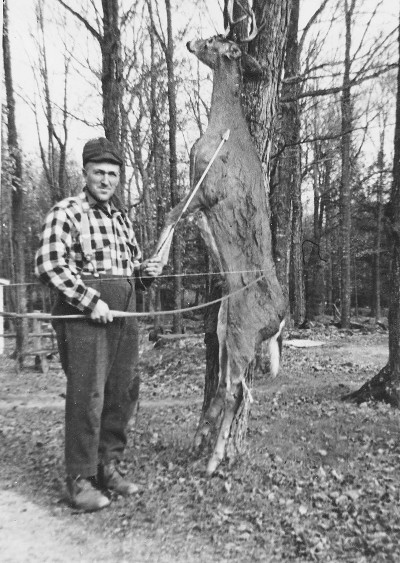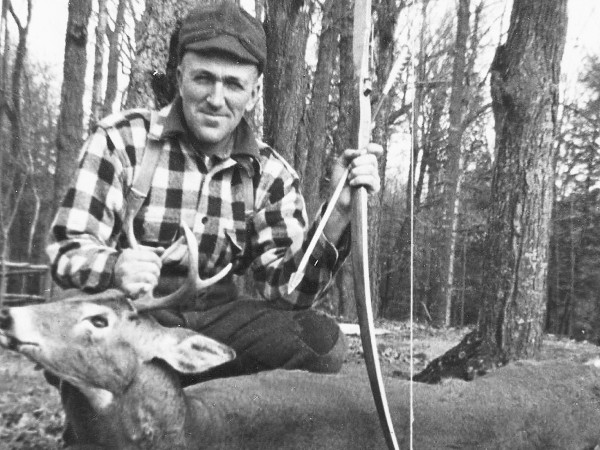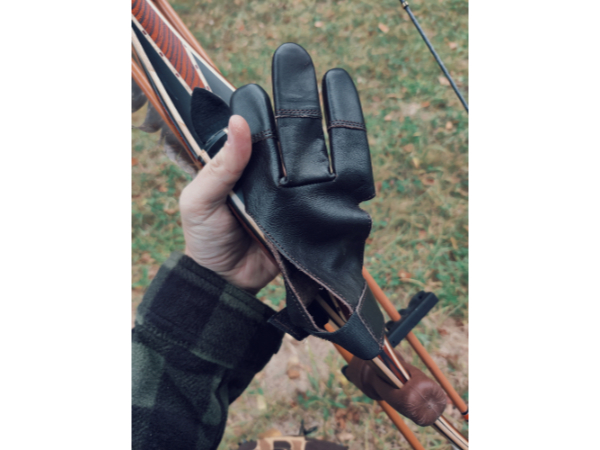You won’t read about him in any “Who’s Who in Archery” books. He’d be far down on any official list of bowhunter luminaries, but nonetheless he’s notable in that he was among the small group of pioneers who were there when our sport was in its infancy. In many ways he is representative of his peers in the early 1940s—an enthusiastic neophyte with a great desire to master this new thing called “bowhunting.”
Jack Coates and his wife, Irma, lived in a little house tucked away in the woods a few miles east of the rural community of Colby, Wisconsin. Although the state had its first archery season for deer in 1934, there were only two counties open at that time. Things didn’t start to get rolling until around 1940, by which time the entire state was involved. That was the year when Jack and Irma “fell heir to one little old lemonwood bow, three arrows, an arm guard, and a shooting tab (for her).”
They practiced faithfully in the dead of winter with their bow, shooting at a cardboard box, and were thrilled when they finally hit it. The east wall of the garage still showed evidence of the many misses years later. When spring came, they made a trip to a sports show and purchased one arrow for the price of 35 cents, evidently so they each had two to shoot. Jack must have caught on pretty quickly. A clipping from 1941 shows that he was not only shooting in tournaments by then, but also winning them. In his second year after taking up the sport, he shot a 535 score for the American Round, taking first place in a local shoot. Out of the 90 arrows, he missed only one. He also shot high score for an End, a 48 at the 40-yard target.
I knew Jack because he was a good friend of my grandfather’s, as well as his bowhunting partner. They were both former riflemen who had sold their guns and gone over to the bow. By the time I had become an aspiring archer, Jack and Irma and had put a twenty-station field course in their woodlot and hosted many of the local archery club shoots. I first shot it when I was about seven or eight years old. Besides the standard targets, I remember a few imaginative ones, like knock-down crows and a rabbit that moved.
Two years later my grandfather passed away, but as my interest in archery grew I kept in touch with Jack and enjoyed hearing about his stories from the old days. “Back when bowhunting was first coming into the state,” he once recounted, “we archers were quite a novelty. Once, I was sitting on a log not far from a fire trail. A pickup truck came bouncing along with two guys in the cab and two in the bed. When the two in the bed saw me, they started pounding on the roof of the cab and yelled for the driver to stop. ‘There’s a bowhunter out here,’ one of them hollered, and everyone jumped out and came running over to look at me. They’d read about guys who went around hunting deer with a bow, but they’d never seen one up close.”
In 1942, Jack took his first deer. According to the account which was published in newspapers around the state, “A 150-pound six-point buck was taken last Saturday in Vilas country with a bow and arrow, by John Coates, Colby……The arrow passed through the shoulder of the buck which was at a distance of 30 yards. The buck was running when shot and dropped about 200 yards from where it was hit. Coates used a 65- pound Osage bow.”
The feat evidently made news because Jack’s buck was one of just five deer taken in the entire state that year, and probably the only one hit with a running shot. He had the hide tanned and had some leather chopper mittens made from it. I have them today, and they are still in new condition. Evidently Jack either never got around to using them or just kept them as a trophy.
Jack recalled another hunting trip when he and his companions stopped at a service station. When the attendant (yes, in those days they pumped the gas for you) saw their equipment in the back seat, he asked if they were bowhunters. “When we said we were,” Jack laughed, “he yanked the hose out of the car and refused to sell us any more gas. I guess we weren’t held in very high regard back then…most of the gun hunters felt that archers had an unfair advantage because of our early season that ran before gun season. They resented that we were getting first crack at all the deer. A lot of folks believed that bows were novelties that lacked the power and accuracy to make clean kills.”
 The following year, Jack connected with another running shot—this time at a spike buck at a distance of 43 yards while hunting out of Otto Blaha’s resort near Manitowish Waters. “The year after I shot that deer,” he recalled, “Otto was kicked out of the local resort owners association just for ‘putting up bowhunters.’ We liked to hunt out of Blaha’s. Otto was a good fellow and it’s a shame they treated him like that because of us. But he did a lot of business with gun hunters, too, so after a while, they let him back in.
The following year, Jack connected with another running shot—this time at a spike buck at a distance of 43 yards while hunting out of Otto Blaha’s resort near Manitowish Waters. “The year after I shot that deer,” he recalled, “Otto was kicked out of the local resort owners association just for ‘putting up bowhunters.’ We liked to hunt out of Blaha’s. Otto was a good fellow and it’s a shame they treated him like that because of us. But he did a lot of business with gun hunters, too, so after a while, they let him back in.
“There were plenty of deer for everyone back then—bow and gun hunters alike. It wasn’t unusual to push out 75 deer on a drive.” Another favorite area, Big Lake, produced “25 or 30 shots a day.”
One kill that he was credited with that he didn’t make, was the one in a story that made the rounds about “a fellow from Colby who made a gosh-awful long shot at a deer running across a fire lane” which was reported to be in excess of 100 yards. A reporter from a local paper who wanted to track the story down knew that the only “fellow from Colby” who could have pulled off such a thing was Jack. “That one was only fifty yards,” Jack corrected the reporter. “But there was a guy from Indiana who killed one that far away up at Blaha’s one fall. This fellow held way high above the deer and the arrow struck the deer in the back and went in at about a 45-degree angle.”
In addition to hunting, field shooting, and targets, Jack liked to experiment with new ideas. One spring when the suckers were running in the Big Eau Plaine River, which bordered his property, he and my grandfather decided to try some bowfishing. Jack designed a device to hold a length of heavy bait casting line from one of my grandfather’s fishing reels, and they designed a barbed point. I can’t remember how many suckers they shot (if any), but they reportedly had a lot of fun trying.
When they weren’t shooting their bows, Jack and Irma were active in archery club activities. They seemed to have memberships in every organization they could drive to in their white Nash, and Irma kept a scrapbook of all their activities. There were at least three local organizations that they were members of and served as officers in all of them at one time or another.
Irma was no slouch with a bow either and won several area tournaments. She also took part in many of the hunts but wasn’t as successful as her husband. One morning, after taking a small (and rare) nip of spirits to ward off the cold, she complained of feeling a bit dizzy after she got to her stand. Shortly afterwards a deer—no make that three identical deer—showed up, all standing side by side. Irma couldn’t decide which one to shoot at and missed them all. Jack’s suggestion to her afterwards was that if that ever happened again, she should just aim for the middle one. Near the end of her hunting career, however, she finally did take a small doe.
After I bagged my first whitetail with a bow, I called the Coates to share the moment. Irma answered the phone and quizzed me about how I pulled it off. When I admitted that I shot the ten-pointer out of a tree after rattling it up, there was a long pause.
“That’s cheating, you know…” she said coldly. Then I realized that back when she and Jack hunted, shooting out of an elevated stand was considered unsportsman-like (as well as being illegal), and rattling was unheard of. Irma always spoke her mind, and you never had to wonder what she was thinking.
Jack continued to hunt for over a quarter of a century. In 1968, as his career was winding down, he made the papers again. The clipping begins, “John Coates, Colby, one of Wisconsin’s earliest bowhunters bagged deer number 9 with the bow recently with a king-sized shot. Hunting near his cottage on Pier lake….he shot a 100-pound doe at 73 yards.” (Not bad for a guy nearly 70 years old!)
I believe that was Jack’s last deer. By that time age was finally catching up with him and he was having a hard time pulling his 55# Bear Kodiak Magnum. In his later years he and Irma traveled to Alaska where they watched game, rather than pursuing it. Jack passed away quietly in 1986. Jack Coates was one of the pioneers. After he got that lemonwood stick, the bow bug bit hard. Archery not only became an all-consuming form of recreation but took over his social life as well. He and Irma made countless new friends in their shooting activities, most of whom were beginners like them and equally enthusiastic about this challenging new game. They tested the limits of their equipment, learned how to hunt by trial and error, shared their experiences, and offered help to whoever might be interested in getting started.
Their camaraderie still remains as part of our legacy as traditional archers.







Leave A Comment